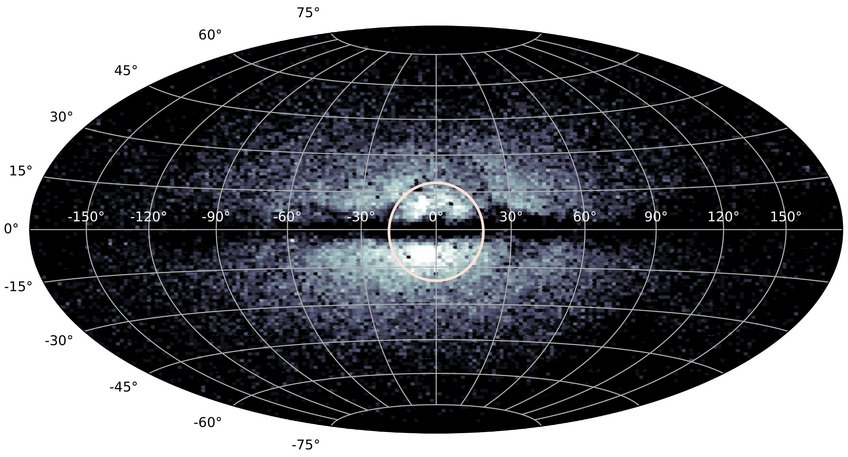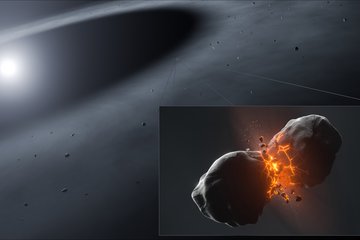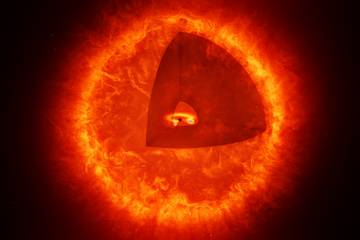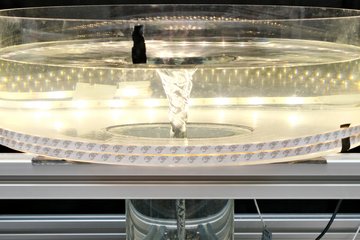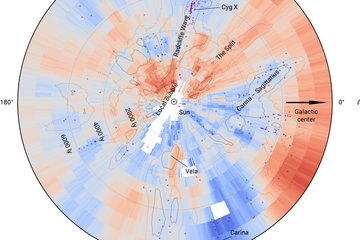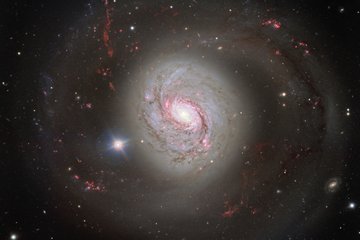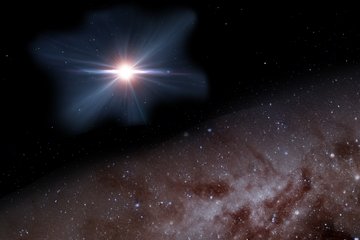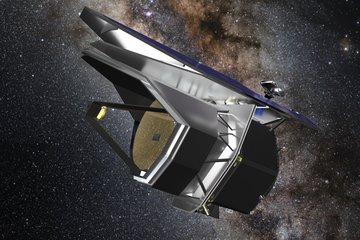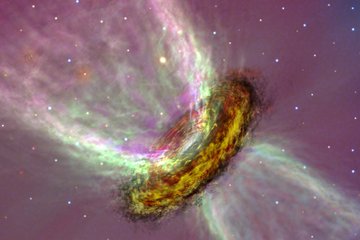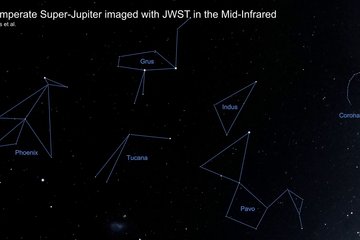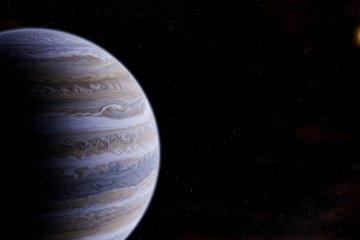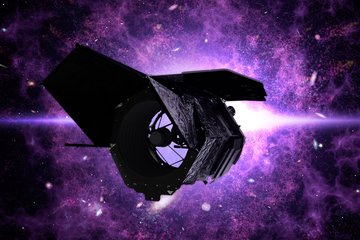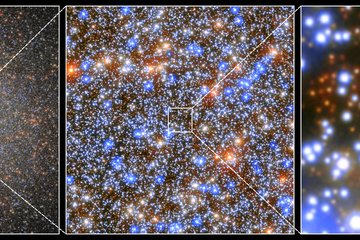Astronomers identify the ancient heart of the Milky Way galaxy
A group of MPIA astronomers has managed to identify the “poor old heart of the Milky Way” – a population of stars left over from the earliest history of our home galaxy, which resides in our galaxy’s core regions. For this feat of “galactic archaeology”, the researchers analyzed data from the most recent release of ESA’s Gaia Mission, using a neural network to extract metallicities for two million bright giant stars in the inner region of our galaxy. The detection of these stars, but also their observed properties, provides welcome corroboration for cosmological simulations of the earliest history of our home galaxy.
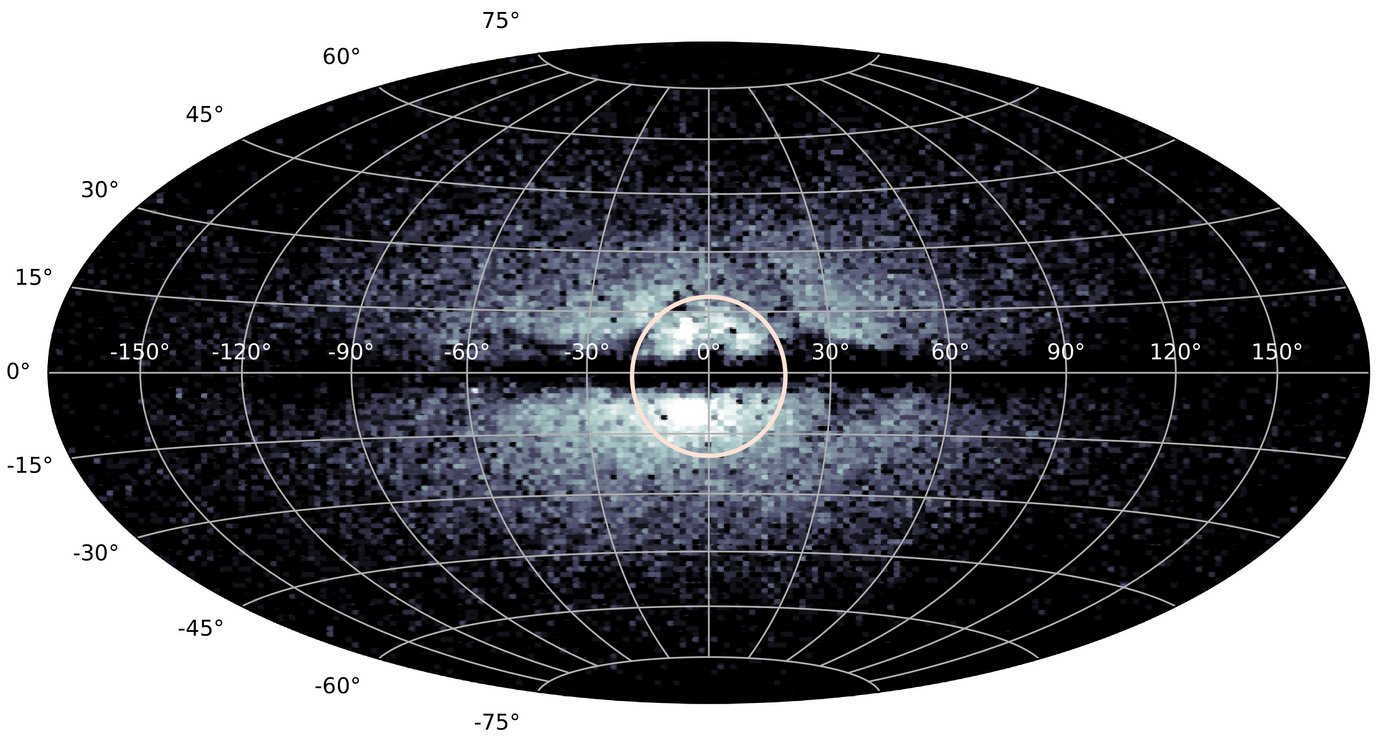
Our home galaxy, the Milky Way, gradually formed over nearly the entire history of the Universe, which spans 13 billion years. Over the past decades, astronomers have managed to reconstruct different epochs of galactic history in the same way that archaeologists would reconstruct the history of a city: Some buildings come with explicit dates of construction.
For others, the use of more primitive building materials or older building styles implies that they have come before, as does the situation where remnants are found underneath other (and thus newer) structures. Last but not least, spatial patterns are important – for many cities, there will be a central old town surrounded by districts that are clearly newer.
For galaxies, and in particular for our home galaxy, cosmic archaeology proceeds along very similar lines. The basic building blocks of a galaxy are its stars. For a small subset of stars, astronomers can deduce precisely how old they are. For example, this is true for so-called sub-giants, a brief phase of stellar evolution where a star’s brightness and temperature can be used to deduce its age.
Estimating age from chemistry
More generally, for almost all stars, there is a “building style” that allows a general verdict on age: a star’s so-called metallicity, defined as the amount of chemical elements heavier than helium that the star’s atmosphere contains. Such elements, which astronomers call “metals”, are produced inside stars through nuclear fusion and released near or at the end of a star’s life – some when a low-mass star’s atmosphere disperses, the heavier elements more violently when a high-mass star explodes as a supernova. In this way, each generation of stars “seeds” the interstellar gas from which the next generation of stars is formed, and generally, each generation will have a higher metallicity than the rest.
As for larger-scale structures, just like in a city, spatial distribution matters. But given that a galaxy is less static than a city – buildings do not usually move around, while stars do – motion patterns encode important information as well. Milky Way stars may be confined to the central regions, or they may be part of an orderly rotating motion in the Milky Way’s thin disk or thick disk. Or else, they may form part of the chaotic jumble of orbits of our galaxy’s extended halo of stars – including very eccentric ones, which repeatedly plunge through the inner and outermost regions.
How large galaxies grow over time
Where cities might undergo construction booms or periods of intensive remodeling, galaxy history is shaped by mergers and collisions, as well as by the vast amounts of fresh hydrogen gas that flow into galaxies over billions of years, the raw material for a galaxy to make new stars. A galaxy’s history starts with smaller proto-galaxies: over-dense regions shortly after the Big Bang, where gas clouds collapse to form stars.
As such, proto-galaxies collide and merge, they form larger galaxies. Add another proto-galaxy to these somewhat larger objects, namely a proto-galaxy that flies in sufficiently off-center (“large orbital angular momentum”), and you may end up with a disk of stars. Merge two sufficiently large galaxies (“major merger”), and their gas reservoirs will heat up, forming a complicated elliptical galaxy combining a dearth of new star formation with a complex pattern of orbits for the existing older stars.
Reconstructing this kind of history is a matter of combining ever-more informative observations with ever-more sophisticated simulations. And while the general picture of what happens as galaxies form and evolve has been around for a number of decades, the specifics have only emerged comparatively recently – thanks in large part to surveys that have yielded better and more comprehensive data. Our home galaxy, the Milky Way, plays a special role in this. By definition, this is the galaxy whose stars we can examine best and in the most detailed way. Galactic archaeology, defined as the study of the history of our home galaxy, not only allows us to reconstruct parts of our own wider history but also to learn something about galaxy evolution in general (“local cosmology”).
What came before the Milky Way’s exciting teenage years?
This particular episode of galactic archaeology began with a reconstruction published in Spring 2022: MPIA researchers Maosheng Xiang and Hans-Walter Rix had made use of data from ESA’s Gaia satellite and from the LAMOST spectral survey to determine the ages of stars in an unprecedented sample of 250,000 so-called sub-giants. From this analysis, the astronomers had been able to reconstruct the consequences of the Milky Way’s exciting teenage years 11 billion years ago and its subsequent more settled (or boring) adulthood.
(The teenage years coincided with the last significant merger of another galaxy, called Gaia Enceladus/Sausage, whose remnants were found in 2018, with the Milky Way. It sparked a phase of intensive star formation and led to a comparatively thick disk of stars we can see today. Adulthood consisted of a moderate inflow of hydrogen gas, which settled into our galaxy’s extended thin disk, with the slow, but the continual formation of new stars over billions of years.)
What the astronomers noticed back then was that the oldest stars in their teenage sample already had considerable metallicity, about 10% as much as the metallicity of our Sun. Clearly, before those stars formed, there must have been even earlier generations of stars that had polluted the interstellar medium with metals.
What simulations tell us about the Milky Way’s ancient core
In fact, the existence of those earlier generations was in line with the predictions from simulations of cosmic history. And furthermore, those simulations predicted where surviving representatives of those earlier generations might reasonably be found! Specifically, in these simulations, the initial formation of what later became our Milky Way involved three or four proto-galaxies that had formed in close proximity and then merged with each other, their stars settling down as a comparatively compact core, no more than a few thousand light-years in diameter.
Later additions of smaller galaxies would lead to the creation of the various disk structures and the halo. But according to the simulations, part of that initial core could be expected to survive these later developments relatively unscathed. It should be possible to find stars from the initial compact core, the ancient heart of the Milky Way, in and near the central regions of our galaxy even today, billions of years later.
In search of ancient core stars
At this point, Rix became interested in ways to actually find stars from our galaxy’s ancient core. But he knew that to come up with more than a few dozen such stars, he would need a new observing strategy. The LAMOST telescope used in the previous study, due to its location on Earth and its inability to observe during the monsoon months in summer, cannot observe the Milky Way’s core regions at all. And sub-giants, as the previous probe of choice, are much too dim to be observable beyond distances of about 7,000 light-years, putting the core regions of our galaxy squarely out of reach.
Recall that in addition to those rare stars where we can determine specific ages, there is the much more general indicator of stellar metallicity – the “varying building styles” that allow one to sort stars into older and younger. Happily, in June 2022 came the Data Release 3 (DR3) of ESA’s Gaia mission. Since 2014, Gaia has been measuring highly accurate position and motion parameters, including distances, for more than a billion stars, revolutionizing (among other sub-fields) galactic astronomy. DR3 was the first data release to include some of the actual spectra Gaia had observed: spectra for 220 million astronomical objects.
Red giants from Gaia
Spectra are where astronomers find information about the chemical composition of a star’s atmosphere, including metallicity. But while Gaia’s spectra are of high quality, and there is an unrivaled number of them, the spectral resolution – how finely the light of an object is split by wavelength into the elementary rainbow colors – is comparatively low by design. Extracting reliable metallicity values from the Gaia data would require extra analysis, and this is what Hans-Walter Rix and René Andrae, a Gaia researcher at MPIA, tackled in a project with their visiting summer student Vedant Chandra from Harvard University.
Since they knew their analysis needed to reach the core regions of the Milky Way, the three astronomers specifically looked at red giant stars in the Gaia sample. Typical red giants are about a hundred times brighter than sub-giants and readily observable even in the distant core regions of our galaxy. These stars also have the added advantage that the spectral features that encode their metallicity are comparatively conspicuous, making them particularly suitable for the kind of analysis the astronomers were planning.
Extracting metallicities with machine learning
For the analysis itself, the astronomers turned to machine learning methods. By now, many people will have come across applications of this innovative technique: software like DALL-E that generates suitable images from simple textual descriptions, or ChatGPT that can more-or-less competently answer questions and fulfill writing requests. The key property of machine learning is that the solution strategies are not programmed explicitly. Instead, at the core of the algorithm is a so-called neural network, with superficial similarities to the way that neurons are arranged in human brains. That neural network is then trained: given combinations of tasks and their solutions, and the connections between input and output adjusted so that, for the training set at least, the network produces the correct output given a specific input.
In this specific case, the neural network was trained using selected Gaia spectra as an input – specifically: Gaia spectra for which the right answer, the metallicity, was already known from another survey (APOGEE, high-resolution spectral observations as part of the Sloan Digital Sky Survey [SDSS]). The network’s internal structure adapted so that, for the training set at least, it could reproduce the correct metallicities.
Reliable metallicities for 2 million bright giants
A general challenge in using machine learning in science is that, by its very nature, the neural network is a “black box” – its internal structure has been formed by the training process and is not under the direct control of the scientists. That is why, to start with, Andrae, Chandra, and Rix trained their neural network only on half of the APOGEE data. In a second step, the algorithm was then set to prove its worth against the rest of the APOGEE data – with spectacular results: the neural network was able to deduce precise and accurate metallicities even for stars it had never encountered before.
Now that the researchers had not only trained their neural network but also ensured that it could obtain precise results for spectra it had not encountered during its training, the researchers applied the algorithm to their full red giant data set of Gaia spectra. Once the results were in, the researchers had access to a sample of accurate metallicities of unprecedented size, consisting of 2 million bright giants in the inner galaxy.
Mapping the ancient heart of the Milky Way
With that sample, it proved comparatively easy to identify the ancient heart of the Milky Way galaxy – a population of stars that Rix has dubbed the “poor old heart”, given their low metallicity, inferred old age, and central location. On a sky map, these stars appear to be concentrated around the galactic center. The distances conveniently supplied by Gaia (via the parallax method) allow for a 3D reconstruction that shows those stars confined within a comparatively small region around the center, approximately 30,000 light-years across
The stars in question neatly complement Xiang’s and Rix’s earlier study of the Milky Way’s teenage years: They have just the right metallicity to have brought forth the metal-poorest of those stars that, later on, formed the Milky Way’s thick disk. Since that earlier study provided a chronology for thick-disk formation, this makes the ancient heart of the Milky Way older than about 12.5 billion years.
Corroboration from chemistry
For the small subset of objects for which APOGEE spectra are available, it is possible to go one step further: These spectra yield additional properties of the poor-old-heart stars in this subset, specifically the abundance of elements like oxygen, silicon, and neon. Those elements can be obtained by successively adding alpha particles (helium-4 nuclei) to existing nuclei in a process called “alpha enhancement”. Their presence in such quantities indicates that the early stars obtained their metals from an environment in which heavier elements were produced on comparatively short time scales via the supernova explosions of massive stars.
This is much more consistent with these stars having formed directly after the first few proto-galaxies had merged to form the Milky Way’s initial core, rather than having already been present in the dwarf galaxies that formed the Milky Way’s initial core or that merged with the Milky Way afterward. It constitutes yet another corroboration of what cosmological simulations have to say about the earliest history of our home galaxy.
A path to finding the Milky Way’s progenitor galaxies?
While the information obtained from Gaia’s global view is ground-breaking in demonstrating the continued existence of our Milky Way’s “poor old heart”, that discovery immediately makes astronomers want to learn more: Can one obtain more detailed spectra for many more or even all of those stars, which allow for a more detailed analysis of their chemical composition? Will they all show alpha enhancement, consistent with their formation in the Milky Way’s initial core? Follow-up spectra taken as part of the recently launched SDSS-V survey or the upcoming 4MOST survey, in both of which MPIA is a partner, promise to allow the group to obtain the information necessary for answering these key questions.
If things go exceptionally well, the additional data might even allow the researchers to identify which stars in the core region belong to which of the Milky Way’s progenitor galaxies: For an older star, like those in the poor old heart, the additional data about chemical composition and temperature allows for a reliable estimate of the star’s luminosity. By comparison with how bright that star is in the sky, one can deduce the star’s distance – the farther away a star is, the dimmer it will appear to us. For the comparatively distant stars in question, distance values obtained in this way are considerably more precise than the results of Gaia’s parallax measurements.
The combination of a star’s position in the sky and its distance gives us the star’s three-dimensional location within the Milky Way. The information about the stars’ motion towards or away from us – measured by the Doppler shift of their spectral lines – combined with their apparent motions on the sky permits the reconstruction of the stars’ orbits within our home galaxy. If such an analysis shows that the stars of the poor old heart belong to two or three different groups, each with its own pattern of motion, those groups are likely to correspond to the different two or three progenitor galaxies whose initial merger created the archaic Milky Way.
Background information
The results described here have been published as Hans-Walter Rix et al., “The Poor Old Heart of the Milky Way,” in the Astrophysical Journal.
The MPIA researchers involved are Hans-Walter Rix, René Andrae, Morgan Fouesneau, and David Hogg (also New York University and Flatiron Institute)
in collaboration with
Vedant Chandra (Center for Astrophysics | Harvard & Smithsonian) and David H. Weinberg (Ohio State University).
MP
